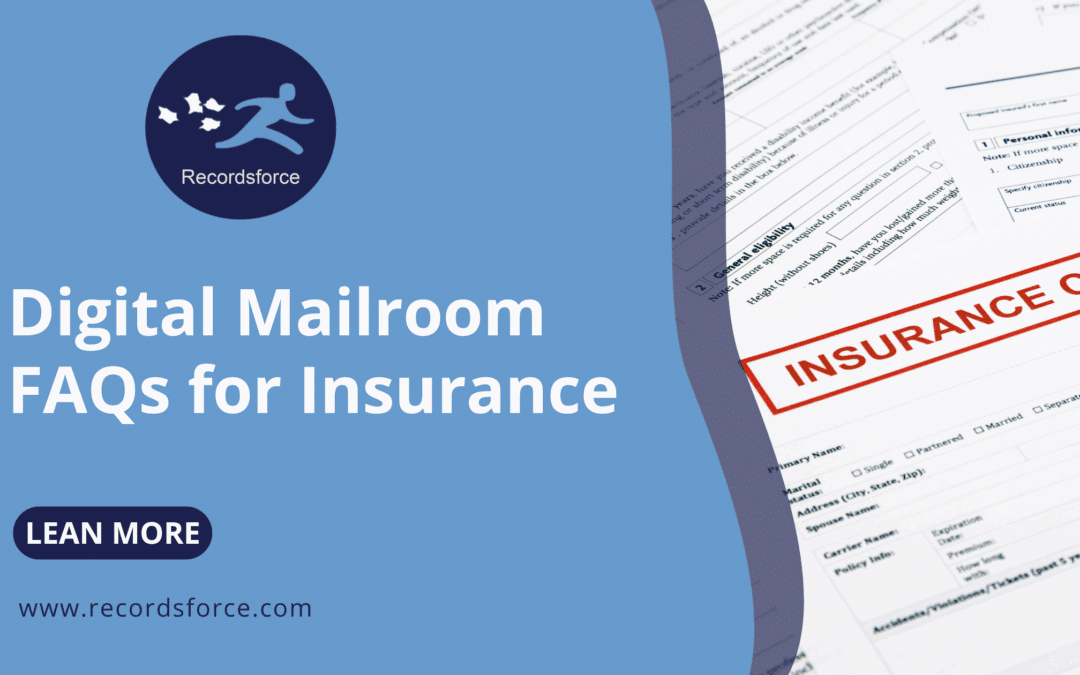Whether you’re processing claims, managing policy changes, or handling compliance documentation, how you manage incoming mail can have a direct impact on customer satisfaction, regulatory risk, and operational costs.
That’s where a digital mailroom comes in. By automating how your organization receives and routes physical mail, you can dramatically improve turnaround times, reduce manual labor, and increase document visibility across teams and systems.
In this blog, we answer the most common questions insurance professionals ask about digital mailroom solutions for insurance.
What is a digital mailroom?
A digital mailroom is a service and solution that receives, scans, and digitizes your incoming mail, converting physical documents into secure, searchable digital files that can be routed electronically to the right departments or systems.
For insurance companies, this means policy documents, claims paperwork, applications, endorsements, checks, and more are all processed and delivered digitally, usually within one business day of being received.
Why should insurance companies consider a digital mailroom?
Because insurance operations depend on fast, accurate, and secure document processing. A digital mailroom can:
- Speed up claims processing and policy changes
- Improve customer response times
- Reduce labor-intensive mailroom operations
- Enable remote and hybrid teams to access critical documents
- Increase compliance with audit and regulatory requirements
- Ensure nothing falls through the cracks
What types of insurance documents can be processed?
Virtually anything that comes into your mailroom or mailbox can be digitized, including:
- Claims forms and supporting documentation
- Loss notices and first notice of loss (FNOL)
- Policy applications and enrollment forms
- Underwriting documents
- Endorsement requests and coverage changes
- Medical records and EOB
- Checks and payment stubs
- Regulatory notices and compliance letters
- Customer correspondence
- Agent communications
All documents are scanned, required data is extracted, and then the images and data are routed to you based on your specifications.
How are claims documents handled?
Claims documents are routed based on rules that direct them to the appropriate claims adjuster or system. You can:
- Set up routing by claim number, policyholder name, or region
- Deliver documents into your claims management system or via secure file transfer
- Flag certain document types (like police reports or photos) for manual review
- Track receipt and access for audit purposes
This speeds up FNOL processing and reduces claim cycle times.
What happens to physical checks and payments?
Checks can be:
- Scanned front and back for records
- Logged and indexed with remittance details
- Deposited electronically if integrated with your lockbox or payment system
- Forwarded to your finance team or securely shredded after confirmation
Many insurers combine lockbox services with a digital mailroom to streamline payments and remittances.
Is a digital mailroom secure enough for handling PHI and PII?
Yes. Insurance documents often contain sensitive information like Social Security numbers, health records, and financial data. A reputable digital mailroom provider will offer:
- SSAE-18 SOC audited facilities
- Encrypted file transfers and storage
- Chain-of-custody tracking
- Role-based access controls and audit trails
- Staff trained in handling PHI/PII under strict confidentiality protocols
How fast can we receive our scanned documents?
Most documents are scanned and delivered within one business day, depending on your service level agreement.
Can the digital mailroom integrate with our policy or claims systems?
Yes. We regularly integrate with:
- Claims management platforms
- Policy admin systems
- Document management and workflow systems
- Secure cloud storage or internal databases
- Or deliver files via secure email or FTP
You receive documents how and where your teams need them, with metadata indexed to match your existing system fields.
How does document classification and indexing work?
We use a combination of AI-powered document recognition and human verification to:
- Identify document types (e.g., claim form, proof of loss, driver’s license)
- Extract key data like policy number, claim number, date of loss, insured name
- Apply custom tags or business rules to route documents properly
- Deliver documents into your system with full-text search and audit trails
This drastically reduces the time your teams spend sorting and filing documents.
What happens to the physical documents after scanning?
You decide. We offer:
- Short-term secure storage (e.g., 30, 60, 90 days)
- Return of originals for sensitive or required materials
- Certified destruction with full chain-of-custody documentation
Your retention and compliance policies determine the handling.
Can it help with regulatory audits or compliance requests?
Absolutely. A digital mailroom:
- Provides timestamped logs of document receipt and access
- Creates tamper-proof digital archives for E&O protection
- Makes it easy to search, export, and retrieve records on demand
- Supports compliance with state and federal regulations like NAIC Model Laws, HIPAA, and GLBA
Is a digital mailroom cost-effective for regional or mid-size insurers?
Yes. Even moderate mail volumes can justify the investment by:
- Reducing staffing needs and overhead
- Improving claims cycle time and customer satisfaction
- Minimizing costly processing errors
- Enabling better scalability during busy seasons
Most insurers see strong ROI within the first few months.
Mail is still a vital part of doing business in insurance, but it doesn’t have to slow you down. A digital mailroom gives your organization the speed, control, and visibility it needs to serve customers better and stay compliant in an increasingly complex industry.
Want to see how it could work for your team?
Contact Recordsforce today to learn how our digital mailroom solutions help insurance companies digitize, streamline, and stay ahead.

